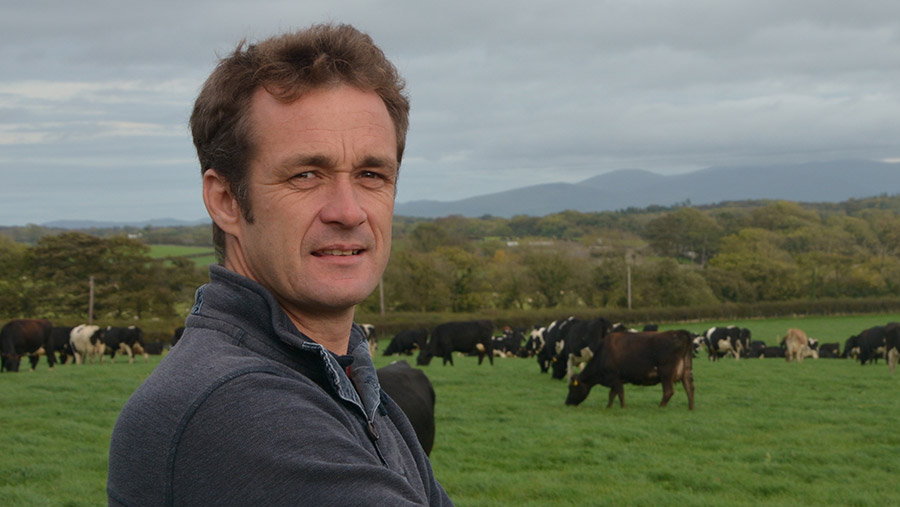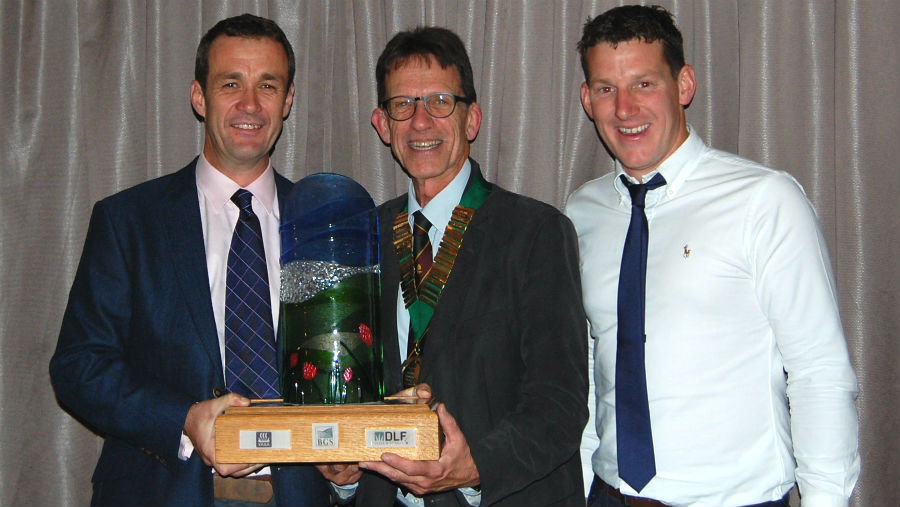New dairy unit wins prestigious BGS Grassland Farmer award
 BGS Grassland Farmer of the Year Richard Rogers
BGS Grassland Farmer of the Year Richard Rogers Richard Rogers of Tre Ifan Farm, Angelsey, has won the coveted 2018 British Grassland Society (BGS) Grassland Farmer of the Year competition.
He was awarded the trophy at last night’s (15 October) annual BGS awards evening, jointly hosted by BGS and Cleddau Grassland Society in Wolfscastle, Pembrokeshire.

Winner Richard Rogers (left), being presented the award from BGS president Prof Chris Reynolds (centre) and Richard’s business partner Gethin Roberts (right).
Originally a traditional beef and sheep farm, Tre Ifan’s grass growing potential became clear to Mr Rogers while it was acting as a demonstration farm.
The milk unit was developed five years ago after a switch to finishing Friesian steers at 24 months.
See also: Why a spring-calving dairy farmer has bought a feeder wagon
Now 350 New Zealand crossbred cows are milked on a 90ha milking platform from mid-February to mid-November.
The cows calve in a tight block for 10 weeks from the start of February and yield 5,349 litres at 4.6% butterfat and 3.7% protein off 1,250kg of concentrate. Careful planning and focus on production from grass has led to a profitable change to dairying.
Commenting on the win, BGS head judge Steve Brandon said: “The yield from forage is exceptional, with yields from grazed grass at 3,200 litres and yields from all forage at 4,099 litres a cow.”
Tre Ifan’s grazing practices
Grass is measured weekly in the growing season and reached 14.36t DM/ha in 2017. A grass budget is calculated using AgriNet. Reseeding is based on productivity, with an objective to replace 10-15% each year.
Nitrogen fertiliser is applied to a maximum of 250kg/ha at three-week intervals starting in early March.
The aim is to make 1.8t DM of conserved forage/cow, with 1,100kg of high-quality silage fed at the shoulders of the season and 700kg of more fibrous silage and hay fed during winter when the cows are dry.
All work is carried out with the environment in mind, with rivers fenced off to provide a wildlife corridor, buffer zones adhered to when fertiliser spreading and wetter paddocks missed in the grazing round to prevent soil damage.
The competition, which involves local, regional and national judging rounds, is supported by DLF Seeds and Yara.
Mr Rogers received the BGS Grass Farmer of the Year trophy and a cheque for £500.
Why Tre Ifan won
- 14.3t of DM/ha
- 21,000 litres milk/ha
- 93% six-week in-calf rate
- 2% empty rate
- Settled, capable, committed team
- Regular financial budgeting/planning
- Member of two discussion groups
The runners-up:

John Egerton
Beef and sheep farmer John Egerton from Lisnavoe Farm, County Fermanagh.
Mr Egerton has developed a paddock grazing system that fits all age groups of beef cattle bred from his suckler herd and also suits the sheep flock.
Pasture improvements have allowed an increase in stocking rates, and dairy heifers are also now being contract reared.
Dairy farmer Chris Brake of Church Farm in Somerset.

Chris Brake
Cows are predominantly autumn calved with a smaller spring block which reduces demand on grazed grass in summer.
Mr Brake looks to maximise milk from grass and maize silage, achieving 3,727 litres/cow from forage from an average yield of 8,598 litres/cow.
